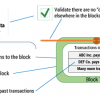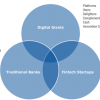Industry
The status quo is changing for most industries as boundaries blur between fields due to innovation, disruption, and digitally-driven change. That’s why keeping abreast of emerging trends in sectors outside your own is vital, not only because your organization’s competitive landscape may be changing, but because there are universal, strategic lessons to learn from the opportunities and threats convergence poses for every marketplace. We examine emerging trends and the impact of evolving tech in key fields such as healthcare, financial services, telco, energy, mobility, and more to help you capitalize on the possibilities of the future while managing the challenges of today.
Recently Published
Asia’s Payments Revolution
The economic gains brought by digital payments are significant. Greater financial inclusion and less friction in commerce lead to increased spending on goods and services. This, in turn, creates a virtuous economic cycle whereby increased consumption translates into more jobs and higher income. Moody’s Analytics estimates that increasing electronic payments contributed an additional $296 billion to consumption between 2011 and 2015, or a 0.1% cumulative increase in global GDP during the period. They also created 2.6 million jobs on average each year. By harnessing payments innovation, Asia can further accelerate its economic growth.
Many observers believe that distributed ledger technology (DLT) will bring fundamental disruption to relationships in a borderless, modern economy that has become more decentralized and more connected than ever. A recent report from the World Economic Forum pointed to blockchain — one potential implementation of DLT — as a revolutionary decentralized trust system that will reshape the global economy. The UK government has been researching DLT for some time now, exploring how the government can use the technology to benefit the country and its citizens. The bank-backed R3 blockchain consortium has gathered key players from the financial markets to work together on blockchain adoption in the financial industry. The year 2016 will definitely be remembered as the moment when blockchain and DLT emerged into the mainstream.
Blockchain is most simply defined as “the first native digital medium for value, just as the Internet was the first native digital medium for information.” Blockchain has gained great attention, investment, and development because it addresses two of the riskiest aspects of life and business on the Internet: transactions and trust. We’ve long recognized the security, privacy, and trust issues that plague the Internet, and since the early 1980s technologists have been working on a solution. For transactions, intermediaries have made possible the trust and security needed to complete transactions and until now have been the best method for completing transactions with trust. However, as we know, security has unfortunately been a weak point, with data breaches leaving individuals’ personal and financial information vulnerable and putting trust at risk.
Digital transformation and technological innovation are reshaping the financial services sector. Today the sector is confronted with both large, established tech companies like Apple, Google, Amazon, and Facebook and small fintech startups that are moving into the financial services space. From a sector perspective, it is clear that a lot of the innovations focus on disintermediating the incumbent organizations. There is a clear move toward more decentralization and peer-to-peer (P2P) collaboration. Blockchain technology enables value transfers through a decentralized, P2P consensus process. International money transfers are drastically improved using P2P operating models, new P2P insurance solutions are created, and both lending and capital raising now take place on P2P platforms.
We hope the articles in this issue of CBTJ will advance the state of the knowledge for all readers, regardless ofyour specific area of interest in fintech. Whether youwish to gain an overview of the emerging fintech themes, broaden your knowledge of blockchain technology, or understand the impact these technologies arehaving on the insurance and payments industries, there are learnings for you here as you continue on yourfintech journey.
Farmers and the agricultural companies that service their needs deal with vast amounts of structured and unstructured data. Analysis of such data gathered from across a variety of growers and growing conditions, combined with data from other sources — including satellite and drone imaging, field-level sensors, weather, and other historic data — can provide insights to enable farmers to make timely decisions that can improve their yields and minimize losses due to unpredictable changes in weather.
Cognitive Technologies in Banking and Finance, Part II
Part I in this two-part Executive Update series covered the use of cognitive systems in banking and finance in three application domains: (1) research and discovery; (2) business intelligence (BI), advisory, and decision support; and (3) risk assessment, compliance, and fraud prevention. This Update expands on the topic and examines the use of cognitive technologies in banking and finance for enhancing customer service and customer experience management.
Cognitive Technologies in Banking and Finance, Part I
Cognitive computing is starting to impact the enterprise by changing the way data is analyzed and the manner in which employees and customers interact with computerized systems. This is happening across various industries, ranging from healthcare and retail to banking and financial services.

















